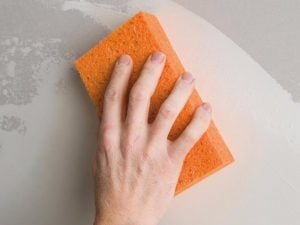[AdSense-A]If you’ve ever dry sanded drywall, then this next statement will come as no surprise. Sanding drywall sucks as it leaves dust and particles in every place imaginable. It seems that no matter what you do to minimize drywall dust it just keeps on coming, and coming, and coming. You’ve probably taken all the necessary steps to minimize this such as using a sander vacuum, draping plastic from one end of the room to the other, and turning your children into the best little helpers you can imagine, but the drywall dust is just too invasive.
Wet sanding drywall is very practical, not to mention it helps alleviate the burden of having the inevitable, become  a reality. Sure you can use your household vacuum to help you after the fact, but little did you know it’s likely to void the manufacturer’s warranty.
a reality. Sure you can use your household vacuum to help you after the fact, but little did you know it’s likely to void the manufacturer’s warranty.
There is one thing you can do to help minimize if not eliminate drywall dust all-together, and we have all the necessary steps for drywall wet sanding below.
- Gather Materials – You’ll need a bucket filled with warm water and a sponge with an abrasive side such as a kitchen sponge
- Get the sponge damp, not soaked
- Using the abrasive side of the sponge, knock down any high spots of the drywall
- Being careful not to press the sponge down too hard on the drywall, move the sponge in a circular, large motion
- Re-wet the sponge while wringing it out. Soaked sponges will tend to will tend to soak the drywall and cause noticeable depressions, or dips.
- Wet sand with the smooth side of the sponge in a circular, large motion
- This is a great opportunity to blend the joint compound in with the drywall joints which will hide noticeable seams which may be seen after painting
- Visibly check to see if you can see the seams. You can also use your finger and run along the drywall where the seams should be to see if there’s a noticeable difference. In theory, the drywall seams should appear and feel as one
Check Out Tips from the Pros on How to Reduce Drywall Dust When Sanding
Pros and Cons of Wet Sanding Drywall
Below are the most noticeable pros and cons of wet sanding drywall:
Pros
- Minimizes or eliminates drywall dust all-together
- In many cases, it’s easier to control sanding deficiencies and seams than conventional sanders
- Minimal cost if any > sponge, bucket, and water is all that’s needed and can typically be found around the house
Cons
- More time consuming and more physical than dry drywall sanding
- Better adapted for small surface areas than larger areas
- Drying times of the drywall can be excessive, especially if you’re waiting to prime or paint
[AdSense-A]





